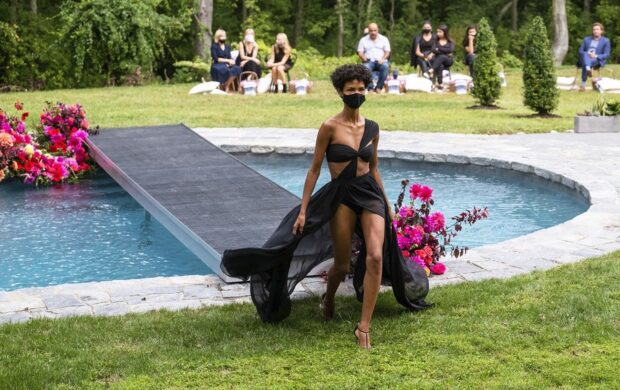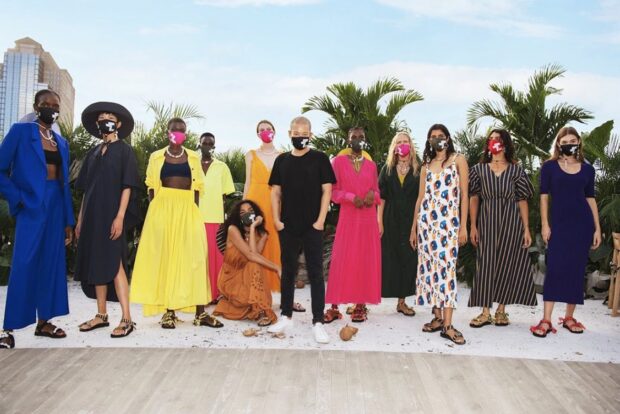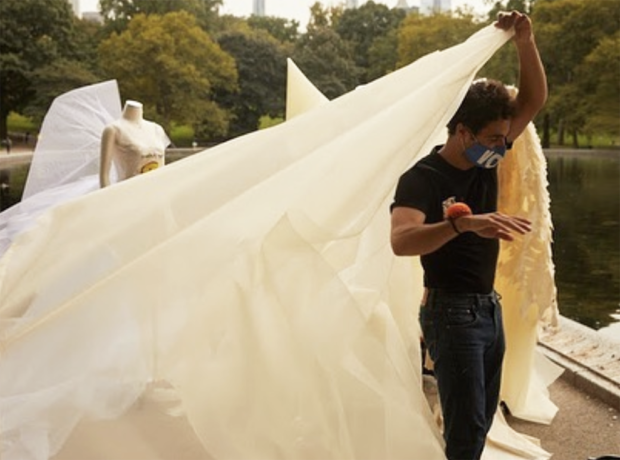
The show of the Christian Siriano collection as part of New York Fashion Week was held at the home of designer Christian Siriano in Westport. Photo Charles Sykes / Invision / AP / TASS
With ultra-short guest lists and masks, shows in parks and on the streets, presentations on Instagram – New York Fashion Week 2020 is over, leaving behind the question of whether such a format is necessary for the fashion industry. We tell how designers are looking for new channels of communication with consumers.
New York is still partially in quarantine, or rather, for several months in the fourth phase of its cancellation. Today, strict requirements for social distance, the wearing of masks in public places, and an uncompromising ban on mass events in closed spaces are still protected. Since the start of the pandemic, the business has received an unprecedented shake-up: from high-profile bankruptcies and reorganizations to calls for a complete reform of the fashion system. For example, the publishing house Conde Nast, which produces Vogue, GQ, and other fashion publications, has pledged to be carbon neutral by 2030. The Council of American Designers (CFDA) issued a statement calling to “slow down”, that is, reduce production turnover, change the approach to the choice of materials and, in general, switch to a conscious consumption of resources.
READ Flea Markets and Antiques: Where to Find Pieces of History in New York
All summer, there were discussions and brainstorming sessions among industry players about what to do with the upcoming Fashion Week, so that they fit into the eco-agenda and not violate the requirement for social distance, and at the same time continue to develop and earn money.
Recently NYFW opened the season of world shows and was held in a classic five-day format, ahead of London, Milan, and Paris. The question – whether the event will take place or not – was not in this case. The main thing that had to be decided by the organizers and the designers themselves was to determine the format in which the Week would be held. NYFW’s structure allows brands to choose their presentation methods based on their own financial capabilities and goals, so everyone did the best they could.
We will tell you what happened in the end: did the event survive under quarantine conditions, does the virtual communication format cope with the tasks set, and most importantly, what to expect next?
The week was opened by Jason Wu with a completely traditional show on the open roof of the official location of Spring Studios, but for only 30 guests, each of whom was required to wear a mask, undergo temperature control, and provide emergency contact for communication. Outdoor shows are an obvious trend in the quarantine reality, but only a few (Jason Wu, Bronx, and Banco, Rebecca Minkoff) could afford to rent commercial roofs and patios, and the rest, according to New York traditions, used their creative resources and imagination.

Photo Jasonwu / Instagram
Christian Siriano, Eckhaus Latta, and Zac Posen also chose the “old school” path and did personal social distancing events, but Siriano hosted the show at his mansion in Connecticut an hour’s drive from Manhattan, designers Eckhaus and Latta – right on the streets of the Lower East Side. and Posen presented a 3-hour performance in Central Park, despite closing his namesake brand last year. In the park, the designer created haute couture dresses in real-time, one of which was decorated with a plastic bag Thank you for Shopping – in this way Zak wanted to celebrate the creative power and resilience of New Yorkers.

Photo Zacposen / Instagram
Still, most brands, even big names like Tom Ford and Michael Kors, simply recorded a video of the show, or shot lookbooks and published them on the main resources (Vogue Runway, Runway360) and on their social networks.
READ Books and Films: What to Watch and Read Before a Trip to New York City
Reaching the latter gives the best results: Story formats, IGTVs, and fresh Instagram Reels are the top communication channels for fashion brands in the States today. For example, the legendary house Carolina Herrera, instead of events and screenings, presented a series of video dialogues between Carolina and the creative director of the house, Wes Gordon. Whether this way will sell collections in the usual volumes will be shown in the coming months.
They will also help to understand how justified the New York Week is today, the rationality of which is questionable due to periodic conflicts between the owners of NYFW, the closedness of the market, and a cosmic pricing policy, which is unlikely to make sense in the current crisis: on average, a place in the official calendar cost from $ 40,000 (according to 2019), the total cost of one show ranges from $ 125,000 to $ 300,000 – and that’s not counting the cost of the clothes themselves.
If we talk about sales, over the past six months, more and more independent fashion companies are focusing on direct-to-consumer sales and building a business strictly online – through their own sites and the same Instagram, where the “Store” function is optimized with each update of the application. And this trend is quite natural – what has been happening to large American retailers over the past year simply leaves no choice.
The largest wave of bankruptcy litigation began with Barneys, which closed its doors in early 2020 (now owned by Authentic Brands Group and operates inside Saks), Neiman Marcus and J.C. Penney barely survived the pandemic, just recently ending their lawsuits into their own advantage, but the rescue of the main competitors is unlikely to please other large department stores – Saks and Macy’s, which are fighting for a buyer in an ongoing quarantine.
READ The Most Instagrammed Locations In New York City
The prerequisites for radical changes in the American fashion and retail system appeared much earlier than the coronavirus crisis, as the speed of digital information flow, the impact of social networks, and the importance of social trends changed the habits and behavior of the local consumer, who began to give preference to cheaper brands that speak understandable to the consumer. language, and fast online shopping.
Giant retailers find it difficult to respond quickly to such changes due to the talent hierarchy and complex financing systems, and now, even staying in the game, despite the threats of bankruptcy, they will continue to focus on the consumer, which no longer exists.
Like us on Facebook for more stories like this: